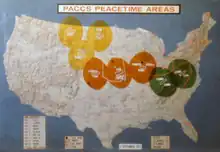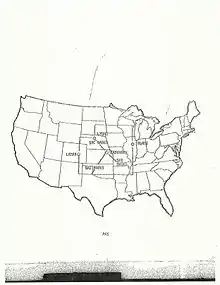Post-Attack Command and Control System
The Post Attack Command and Control System (PACCS) was a network of communication sites (both ground and airborne) for use before, during and after a nuclear attack on the United States. PACCS was designed to ensure that National Command Authority would retain exclusive and complete control over US nuclear weapons. Among other components, it included Strategic Air Command assets such as the Looking Glass aircraft and mission, and various hardened command and control facilities.[1]
The belief by the Soviet Union in the reliability of PACCS was a crucial component of the US mutual assured destruction doctrine, ensuring a long-term stalemate.

History
The Strategic Air Command headquarters staff, under the direction of General Thomas S. Power assessed the feasibility of placing a continuous command and control element in an airborne mode. The purpose of such a system would be to use the aircraft as a platform for specially installed communications equipment to ensure delivery of command directives to SAC strike forces in the event ground-based headquarters were destroyed.
The original plan envisioned an aircraft, crew, and command and control team on 15-minute ground alert. This was later changed to a continuous airborne alert posture. The functions of this PACCS Airborne Command Post kept expanding until it became a true alternate command and control system, complete with force status monitoring, initiation or relay of launch/execution directives, a battle staff, communications to support an alternate CINCSAC, and limited capabilities to reconstitute and replan residual resources.
PACCS, in later variants, included an Airborne Launch Control System (ALCS) capability, which provided an alternate means for execution message delivery to missile combat crews and a back-up launch control center, forcing the Soviet Union to target each missile silo, rather than just the launch control centers to incapacitate the Minuteman force.[2]
Components
Airborne
- E-4B National Emergency Airborne Command Post (NEACP)
- EC-135 Airborne Command Post (ABNCP) "Looking Glass"
- 2d Airborne Command and Control Squadron - Offutt Air Force Base, Nebraska
- 4th Airborne Command and Control Squadron - Ellsworth Air Force Base, South Dakota
- 22d Air Refueling Squadron - March Air Force Base, California; West Auxiliary Command Post (West AUXCP) [3]
- Ground Entry Point - Lamar, Colorado[4]
- 99th Air Refueling Squadron - Westover Air Force Base, Massachusetts; East Auxiliary Command Post (East AUXCP) [5]
- Ground Entry Point - Plano, Illinois[4]
- 913th Air Refueling Squadron - Barksdale Air Force Base, Louisiana; Central Auxiliary Command Post (Central AUX)
- Ground Entry Point - Lyons, Nebraska[4]
- EB-47L
- 4362d Post Attack Command and Control Squadron - Lincoln Air Force Base, Nebraska[6]
- 4363d Post Attack Command and Control Squadron - Lockbourne Air Force Base, Ohio[6]
- 4364th Post Attack Command and Control Squadron - Mountain Home Air Force Base, Idaho[6]
- 4365th Post Attack Command and Control Squadron - Plattsburgh Air Force Base, New York[6]
Ground
- Barksdale Air Force Base, Louisiana (Second Air Force (later Eighth Air Force) Command Post)
- Westover Air Force Base, Massachusetts (Eighth Air Force Combat Operations Center, aka "The Notch")[7]
- March Air Force Base, California (Fifteenth Air Force Command Post)
- Grissom Air Force Base, Indiana
- Offutt Air Force Base, Nebraska (Strategic Air Command Headquarters)
Communications
- Survivable Low Frequency Communications System - VLF/LF
- Alpha and Bravo Nets - High Frequency[4]
- Green Pine[4]
- Emergency Rocket Communications System[4]
Gallery
 ALPHA Net stations
ALPHA Net stations PACCS UHF Links
PACCS UHF Links PACCS Primary Alert System
PACCS Primary Alert System
See also
- Airborne Launch Control Center
- Survivable Low Frequency Communications System (SLFCS)
- Ground Wave Emergency Network (GWEN)
- Minimum Essential Emergency Communications Network (MEECN)
- Emergency Rocket Communications System (ERCS)
- Alternate Reconstitution Base (ARB)
- Cold War
- Game theory
- Continuity of government
References
- Ogletree, Greg (n.d.). "A History of the Post Attack Command and Control System (PACCS)". Archived from the original on September 10, 2012. Retrieved May 14, 2014.
- Strategic Air Command: "Weapon Systems Acquisition 1964-1979", 28 Apr 1980
- 2d Airborne Command and Control Squadron history
- IRIS #010808041 - Post Attack Command and Control System overview
- Strategic Air Command Regulation 100-24 Vol III: SAC Communications System Operations/EWO Support Requirements, 6 Jul 1979
- Lloyd, Alwyn T. (January 15, 2000). A Cold War Legacy: A Tribute to Strategic Air Command 1946-1992. Missoula, Montana: Pictorial Histories Publishing. ISBN 1-57510-052-5. OCLC 44672618.
- "Westover Yesterday: "The Notch and Grayson: Eighth Air Force's alternative command posts", no date". Archived from the original on 2017-11-15. Retrieved 2010-03-06.
- Yahoo! Groups: Cold War Comms Msg 17285, dated Jun 24, 2010